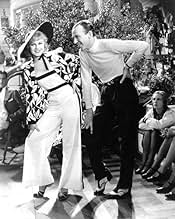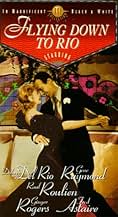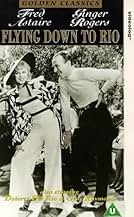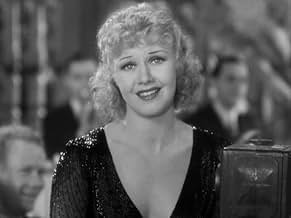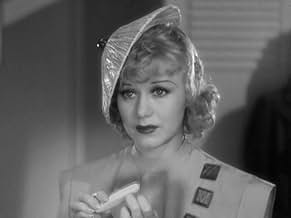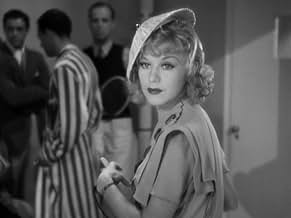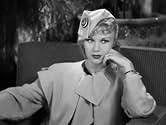NOTE IMDb
6,6/10
4,2 k
MA NOTE
Ajouter une intrigue dans votre langueA bandleader woos a Latin flame who is already engaged to his employer.A bandleader woos a Latin flame who is already engaged to his employer.A bandleader woos a Latin flame who is already engaged to his employer.
- Réalisation
- Scénario
- Casting principal
- Nommé pour 1 Oscar
- 1 victoire et 2 nominations au total
Dolores Del Río
- Belinha De Rezende
- (as Dolores Del Rio)
Luis Alberni
- Rio Casino Manager
- (non crédité)
Bernice Alstock
- Singer
- (non crédité)
Chita Andrews
- Check Girl
- (non crédité)
Avis à la une
I gave this "Fred Astaire" comedy-romance-musical higher marks than normal because the romance, usually the sappy part of the Astaire films, doesn't dominate as it does most of his movies.
As usual, there are a number of interesting dance scenes including a spectacular Busby Berkeley-type production on the wings of airplanes. That scene has to be seen to be believed, not just for the uniqueness of it but for the bra-less women pictured! Yikes, it's not something you expect to see with a classic film - and you wouldn't see for another 35 years. It's pretty amazing.
I really shouldn't label this an "Astaire film " because Dolores Del Rio and Gene Raymond are the two stars. Astaire is a close third. Raul Roulien would be next while Ginger Rogers just has a small role.....but it IS noteworthy for being the first time all of us saw the famous Astaire-Rogers pairing.
The comedy in this film also is pretty good. The best parts of the film are the beginning and end. The fadeout segways in here reminded of silent films, which weren't that long removed from this.
As usual, there are a number of interesting dance scenes including a spectacular Busby Berkeley-type production on the wings of airplanes. That scene has to be seen to be believed, not just for the uniqueness of it but for the bra-less women pictured! Yikes, it's not something you expect to see with a classic film - and you wouldn't see for another 35 years. It's pretty amazing.
I really shouldn't label this an "Astaire film " because Dolores Del Rio and Gene Raymond are the two stars. Astaire is a close third. Raul Roulien would be next while Ginger Rogers just has a small role.....but it IS noteworthy for being the first time all of us saw the famous Astaire-Rogers pairing.
The comedy in this film also is pretty good. The best parts of the film are the beginning and end. The fadeout segways in here reminded of silent films, which weren't that long removed from this.
The first pairing of Astaire and Rogers, playing second leads to Dolores DelRio and a slightly strabismic Gene Raymond. What music and what dancing!!! And the scenery of 1933 Rio is worth seeing. The story is slight, the acting is slighter but who cares when Astaire and Rogers take the floor for the Carioca. How silly is the concept of a bunch of girls strapped to the wings of airplanes performing over the hotel? But again, who cares?...it's history on film as the seminal appearance of the most famous dance team in the movies. The supporting players are good but what became of Raul Roulien?.....the rest are familiar to fans of old movies. Love the music,(even Orchids in the Moonlight)and especially the title tune which is rather forgotten now. Step back in time and enjoy this dated, but absolutely wonderful film. You won't be sorry and maybe you will dance the Carioca!!
FLYING DOWN TO RIO (RKO Radio, 1933), directed by Thornton Freeland, is a musical showcase for Mexican star Dolores Del Rio playing a Brazilian beauty named Belinia De Rezende, Gene Raymond as Roger Bond, a girl chasing orchestra leader, and Raul Roulien as Julio Rubeiro as Belinia's fiancé and Roger's best friend who complicates matters. By the film's conclusion, the ones who "walked off" with the movie are the supporting players of Ginger Rogers as the band vocalist, and Fred Astaire as the accordionist-dancer, in that order, thus, the beginning of a new screen team, and never again in the persona of sassy Honey Hale and semi-sophisticated Fred Ayres. Yet it's amazing that Astaire and Rogers made such a lasting impression at all in this production, considering they play subordinate roles who supply "comedy relief," and have very little opportunity to act or dance together. Even in the famous, "Carioca," number (which was how they became crowned "The King and Queen of the Carioca"), they get to perform only a few dance steps, but the ensemble of other dancers and singers get most of the footage during its 12 minutes. But even without Astaire and Rogers, or either with one of them along with a different partner, FLYING DOWN TO RIO remains an early musical attempt to capture that South American feel and tango rhythm, predating all those cliché musicals MGM or 20th Century-Fox would distribute in the 1940s, with the addition of Technicolor and/or Xavier Cugat and Carmen Miranda, etc. As for the plot elements, it remains similar to the ones used in subsequent Astaire and Rogers films, but this time the situations of strangers meeting followed by a merry mix-up, belongs to its leading players (Del Rio, Raymond and Roulien). The first half of the movie takes place in Miami, Florida, where the plot development amongst the central characters begin, then shifts to Rio De Janiero, the second largest city in Brazil, where the complications continue and are resolved after 89 minutes of screen time. In between all this comes the singing and dancing to help the plot along.
With the music and lyrics by Gus Kahn, Edward Eliscu and Vincent Youmans, the songs include: "Music Makes Me" (sung by Ginger Rogers in the foreground with Fred Astaire, as one of the members of the band, playing the accordion in the background); "The Carioca" (performed by musicians, danced by numerous Brazilians, sung by Movita and Etta Moten, and danced briefly by Astaire and Rogers); "Orchids in the Moonlight" (sung by Raul Roulien to Dolores Del Rio/reprise, danced by Astaire and Del Rio, with one observer saying to another, "Oh, look, Belinha is dancing our tango with an Americano."); "Music Makes Me" (tap dance solo by Astaire); and "Flying Down to Rio" (sung by Fred Astaire/ danced by girls chained to the wings of the flying airplanes).
Other than some advanced camera techniques used in this production, portions of the movie play like a picture postcard advertisement, mainly during its montage sequences where the camera focuses first from an air-view of famous landmarks, then from the ground view of Rio De Janiero, and flipping over to other scenes of the city from people walking the streets to cars driving down the roads before returning to the storyline.
In the supporting cast are Blanche Frederici as Belinda's old-fashioned Aunt (Tia) Elena; Roy D'Arcy, Maurice Black and Armand Kaliz (The Greeks); Franklin Pangborn (Mr. Hammerstein); Luis Alberni (The Rio Casino Manager); and Eric Blore (Mr. Butterbass), making his first of five performances in an Astaire and Rogers musical. He is an asset to every one of them. It's also interesting to note that Raul Roulien remained somewhat obscure after appearing in this, never to become the Cesar Romero-type of Hollywood. As for the few Hollywood movies to feature him in the early 1930s, this is the only one still in circulation today and possibly his best opportunity on screen.
When Gene Raymond was interviewed about FLYING DOWN TO RIO in the documentary on RKO Radio titled "Hollywood, the Golden Years" (as narrated by Ed Asner back in the late 1980s), he mentioned that he thought that FLYING DOWN TO RIO was going to become the "Bomb of Bombs," but much to his surprise when it made its premiere during the Christmas season at Radio City Music Hall, he noticed while being in New York City that there was a long line of people going around the block waiting to go in and see this movie. One cannot be sure that history would repeat itself again in today's society, but FLYING DOWN TO RIO, in spite of whatever is right or wrong it it, is vintage entertainment at best. Only one debit: acrobats flipping and catching one other, and hanging on the swings under the wings of the flying airplane during the "Flying Down to Rio" number. Not realistic, but it got by. And on the historical side, this is where Astaire and Rogers got their start together on screen, thus, becoming the most popular song and dance team of the movies, never to be topped or equaled by anyone. Now that's something to think about!
FLYING DOWN TO RIO, which was formerly shown on American Movie Classics for many years, is currently presented on Turner Classic Movies. It is also available on video cassette and DVD. Recommended highly to fans of the team and/or musicals from this era. (***1/2)
With the music and lyrics by Gus Kahn, Edward Eliscu and Vincent Youmans, the songs include: "Music Makes Me" (sung by Ginger Rogers in the foreground with Fred Astaire, as one of the members of the band, playing the accordion in the background); "The Carioca" (performed by musicians, danced by numerous Brazilians, sung by Movita and Etta Moten, and danced briefly by Astaire and Rogers); "Orchids in the Moonlight" (sung by Raul Roulien to Dolores Del Rio/reprise, danced by Astaire and Del Rio, with one observer saying to another, "Oh, look, Belinha is dancing our tango with an Americano."); "Music Makes Me" (tap dance solo by Astaire); and "Flying Down to Rio" (sung by Fred Astaire/ danced by girls chained to the wings of the flying airplanes).
Other than some advanced camera techniques used in this production, portions of the movie play like a picture postcard advertisement, mainly during its montage sequences where the camera focuses first from an air-view of famous landmarks, then from the ground view of Rio De Janiero, and flipping over to other scenes of the city from people walking the streets to cars driving down the roads before returning to the storyline.
In the supporting cast are Blanche Frederici as Belinda's old-fashioned Aunt (Tia) Elena; Roy D'Arcy, Maurice Black and Armand Kaliz (The Greeks); Franklin Pangborn (Mr. Hammerstein); Luis Alberni (The Rio Casino Manager); and Eric Blore (Mr. Butterbass), making his first of five performances in an Astaire and Rogers musical. He is an asset to every one of them. It's also interesting to note that Raul Roulien remained somewhat obscure after appearing in this, never to become the Cesar Romero-type of Hollywood. As for the few Hollywood movies to feature him in the early 1930s, this is the only one still in circulation today and possibly his best opportunity on screen.
When Gene Raymond was interviewed about FLYING DOWN TO RIO in the documentary on RKO Radio titled "Hollywood, the Golden Years" (as narrated by Ed Asner back in the late 1980s), he mentioned that he thought that FLYING DOWN TO RIO was going to become the "Bomb of Bombs," but much to his surprise when it made its premiere during the Christmas season at Radio City Music Hall, he noticed while being in New York City that there was a long line of people going around the block waiting to go in and see this movie. One cannot be sure that history would repeat itself again in today's society, but FLYING DOWN TO RIO, in spite of whatever is right or wrong it it, is vintage entertainment at best. Only one debit: acrobats flipping and catching one other, and hanging on the swings under the wings of the flying airplane during the "Flying Down to Rio" number. Not realistic, but it got by. And on the historical side, this is where Astaire and Rogers got their start together on screen, thus, becoming the most popular song and dance team of the movies, never to be topped or equaled by anyone. Now that's something to think about!
FLYING DOWN TO RIO, which was formerly shown on American Movie Classics for many years, is currently presented on Turner Classic Movies. It is also available on video cassette and DVD. Recommended highly to fans of the team and/or musicals from this era. (***1/2)
Howard Hughes, oh how we needed you.
From other sources you will have learned that this is pretty sexy stuff in terms of transparent clothes; not a bra on the hundreds of candidates. And the original dirty dancing before it was outlawed, and that crack about what Brazilian women have "below the equator." Also, you will have heard about this being the first Astaire-Rogers pairing.
You may not have heard of one of the most racially respectful scenes I know from the era: a couple land on a supposedly deserted island and the woman is frightened by what she thinks are natives. Turns out one comes out of the woods. He's playing golf and while shirtless (in order to make the joke work) speaks English normally and carries himself like a regular man. Its the reverse joke of what you'd usually see in bugeyed stepinfetchits.
But what I find fascinating is the way sex, romance, money and music are all somehow related to aviation. Our hero, we are told is heir to a fortune if only he would give up his music and planes. But it is plain that he does it because of the women. And by that we know he means sex, only sex. We first see him as he climbs out of his plane, which has a piano stuffed in it. Now think about that a minute.
This is what technology meant in those days: adventure, charm, bodily pleasure. And its what the sort of music we see in films was supposed to imply as well. If you do not see this, let me describe the climax. Scores of scantily clad women are strapped to what looks like a dozen small planes to perform choreographically as best you can when bolted down. Every shot you can take of a woman's body is presented, along with a wingload of errant nipples. I can just imagine the smiles when they thought it up.
There's something else to watch for. This has the most elaborate transitions I believe I have seen for any film. They really are amazingly varied and so copious they are as much a feature as Fred's dancing.
Ted's Evaluation -- 2 of 3: Has some interesting elements.
From other sources you will have learned that this is pretty sexy stuff in terms of transparent clothes; not a bra on the hundreds of candidates. And the original dirty dancing before it was outlawed, and that crack about what Brazilian women have "below the equator." Also, you will have heard about this being the first Astaire-Rogers pairing.
You may not have heard of one of the most racially respectful scenes I know from the era: a couple land on a supposedly deserted island and the woman is frightened by what she thinks are natives. Turns out one comes out of the woods. He's playing golf and while shirtless (in order to make the joke work) speaks English normally and carries himself like a regular man. Its the reverse joke of what you'd usually see in bugeyed stepinfetchits.
But what I find fascinating is the way sex, romance, money and music are all somehow related to aviation. Our hero, we are told is heir to a fortune if only he would give up his music and planes. But it is plain that he does it because of the women. And by that we know he means sex, only sex. We first see him as he climbs out of his plane, which has a piano stuffed in it. Now think about that a minute.
This is what technology meant in those days: adventure, charm, bodily pleasure. And its what the sort of music we see in films was supposed to imply as well. If you do not see this, let me describe the climax. Scores of scantily clad women are strapped to what looks like a dozen small planes to perform choreographically as best you can when bolted down. Every shot you can take of a woman's body is presented, along with a wingload of errant nipples. I can just imagine the smiles when they thought it up.
There's something else to watch for. This has the most elaborate transitions I believe I have seen for any film. They really are amazingly varied and so copious they are as much a feature as Fred's dancing.
Ted's Evaluation -- 2 of 3: Has some interesting elements.
This movie is typical of its time in the 'two guys and a girl' storyline, this time over the alluring Doleres del Rio (scarily, she looked much the same as this as Elvis Presley's mother in 'Flaming Star' years later). Gene Raymond plays the conniving bandleader who chases her from Miami to Rio, with an impromptu island stop en route.
There are some nice touches (the ghostly 'consciences' of Raymond and del Rio for one, the back projection of orchids and palm trees showcasing her thoughts as her local hick boyfriend sings 'Orchids in the Moonlight') but of course the real interest of this movie is for two reasons - one, the clever and inventive acrobatic stuff with the girls tied to aeroplane wings etc over a new nightspot; and two, the first screen teaming of Fred Astaire and Ginger Rogers, who light up the movie with 'The Carioca'. Fred may have been far from a looker but there is no denying his talent and there was certainly ample chemistry with Rogers for the teaming to work. They'd go on to brighter and better things through the 30s, but this film is fun.
There are some nice touches (the ghostly 'consciences' of Raymond and del Rio for one, the back projection of orchids and palm trees showcasing her thoughts as her local hick boyfriend sings 'Orchids in the Moonlight') but of course the real interest of this movie is for two reasons - one, the clever and inventive acrobatic stuff with the girls tied to aeroplane wings etc over a new nightspot; and two, the first screen teaming of Fred Astaire and Ginger Rogers, who light up the movie with 'The Carioca'. Fred may have been far from a looker but there is no denying his talent and there was certainly ample chemistry with Rogers for the teaming to work. They'd go on to brighter and better things through the 30s, but this film is fun.
Le saviez-vous
- AnecdotesStanding outside a bakery shop in Rio, Ginger Rogers asks, "Oh, Freddie, how do you ask for little tarts in Portuguese?" Fred Astaire replies, "Don't heckle me, try the Culbertson System." This pre-Code, double entendre joke would have been funny to Depression-era audiences, for whom bridge was a common pastime. Ely Culbertson was a champion bridge player and worldwide celebrity, who had won several international tournaments by developing a rather aggressive bidding system. He was also notorious for his sexual exploits. His 1940 autobiography was banned in many countries. In the 1930s, the word "tart" was equivalent to "slut" or "whore". Also, in the opening inspection of hotel staff, the boss sees a maid whose shoe heels are oddly beveled and says he will not tolerate that sort of thing. A "round-heeled woman" was 1930s slang for a prostitute, a woman who could tilt easily from standing to being on her back.
- GaffesFrom the height they were flying, most of the "dance" routines of the young women on the plane wings would not be visible to people on the ground.
While true, this observation is not a Goof. The purpose of the event likely was more for advertising or Newsreel value, or even simply "bragging rights".
- Citations
Belinha's Friend: What have these South Americans got below the equator that we haven't?
- ConnexionsFeatured in Hollywood and the Stars: The Fabulous Musicals (1963)
- Bandes originalesMusic Makes Me
(1933) (uncredited)
Music by Vincent Youmans
Lyrics by Gus Kahn and Edward Eliscu
Performed by Ginger Rogers
Meilleurs choix
Connectez-vous pour évaluer et suivre la liste de favoris afin de recevoir des recommandations personnalisées
- How long is Flying Down to Rio?Alimenté par Alexa
Détails
Box-office
- Budget
- 462 000 $US (estimé)
- Durée1 heure 29 minutes
- Couleur
- Rapport de forme
- 1.37 : 1
Contribuer à cette page
Suggérer une modification ou ajouter du contenu manquant




